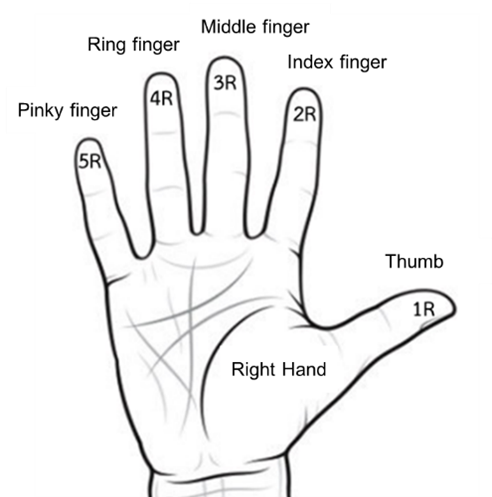การสำรวจวัสดุที่ใช้เป็นหีบห่อยาเสพติดและศึกษาเปรียบเทียบวิธีการตรวจเก็บลายนิ้วมือบนวัสดุที่ใช้เป็นหีบห่อโดยอาศัยข้อมูลการเก็บลายนิ้วมือแฝงบนหีบห่อ ยาเสพติดที่ส่งตรวจพิสูจน์ในพื้นที่ศูนย์พิสูจน์หลักฐาน 7 เป็นกรณีศึกษา | A Comparative Study of Fingerprint Developing Methods on Narcotics Packaging Collected with Latent Fingerprints for Identification in Police Forensic Science Center 7
Main Article Content
Abstract
A comparative study of a fingerprint detection method without DNA contamination on narcotics packaging could reveal connected evidence, both fingerprints and DNA, to the perpetrators. According to a survey conducted by the Police Forensic Science Center 7, polypropylene (PP) bags were used for containing a narcotic, the most being 31.25%. Therefore, PP was selected as a material to examine the quality of latent fingerprints by magnetic powder, superglue and superglue followed by a magnetic powder method. The naturally sweaty and loaded fingerprints of six volunteers were pressed on the PP with all five fingers and continued to be pressed to other piece of PP six times. It was found that all 3 methods gave an effective difference at the significant level of 95% (p<0.05). The magnetic powder was the most effective method. Superglue showed less effective than magnetic method. Superglue followed by magnetic powder showed the least effective method. Although the fingerprints collected by the superglue followed by magnetic powder method was a low mean of minutiae, it could verify a person due to a value greater than 10 points without causing DNA contamination.
บทคัดย่อ
การศึกษาเปรียบเทียบประสิทธิภาพวิธีตรวจเก็บลายนิ้วมือโดยไม่ทำให้เกิดการปนเปื้อนดีเอ็นเอบนวัตถุพยานหีบห่อยาเสพติด สามารถเชื่อมโยงพยานหลักฐานทั้งลายนิ้วมือและดีเอ็นเอไปสู่ตัวผู้กระทำความผิดได้ จากการสำรวจข้อมูลของศูนย์พิสูจน์หลักฐาน 7 พบว่าถุงพอลิพอพิลีน (Polypropylene, PP) ใช้สำหรับบรรจุสารเสพติดมากที่สุดถึง 31.25% ดังนั้น PP จึงถูกเลือกเพื่อเป็นวัตถุพยานจำลองในการศึกษาเปรียบเทียบประสิทธิภาพวิธีตรวจเก็บด้วยผงฝุ่นแม่เหล็ก ซุปเปอร์กลู และซุปเปอร์กลูแล้วปัดผงฝุ่นแม่เหล็ก ลายนิ้วมือที่มีเหงื่อตามธรรมชาติและที่มีไขมันของอาสาสมัคร 6 คนถูกกดลงบน PP โดยใช้นิ้วมือทั้ง 5 นิ้ว และกดต่อเนื่องที่ชิ้นอื่นจำนวน 6 ครั้ง จากผลการวิจัยพบว่าทั้ง 3 วิธีให้ประสิทธิผลแตกต่างกันอย่างมีนัยสำคัญทางสถิติที่ระดับ 95 % (p<0.05) วิธีปัดผงฝุ่นแม่เหล็กมีประสิทธิภาพมากที่สุด วิธีอบซุปเปอร์กลูมีประสิทธิภาพน้อยกว่าผงฝุ่นแม่เหล็ก ส่วนวิธีอบซุปเปอร์กลูตามด้วยผงฝุ่นแม่เหล็กมีประสิทธิภาพน้อยที่สุด แม้ว่าวิธีนี้จะมีค่าเฉลี่ยจุดสำคัญต่ำแต่ก็ยังสามารถใช้ตรวจเก็บลายนิ้วมือได้โดยปราศจากการปนเปื้อนดีเอ็นเอ
Downloads
Article Details
References
Attaphol Chamsuwanwong. (2001). Forensic Science 2 for Crime Investigation. Bangkok: TCG printing.
Benjapon Promlee and Sirirat Choosakoonkriang. (2014). Examination of grip-seal plastic bags for packaging illicit drugs by ATR-FTIR and TGA techniques. Veridian E-Journal Science and Technology Silpakorn University. 1(2), 24-35.
Ekachai Paramakul. (2018). The Experimental Study of Latent Fingerprints’ Stability on Black Garbage bag (Thin type) by Superglue Fuming and Rhodamine-6G Dyeing. (master’s thesis). Bankok: Suansunandha Rajabhat University.
Girdthep, S., Limwanich, W., & Punyodom, W. (2022). Non-isothermal cold crystallization, melting, and moisture barrier properties of silver-loaded kaolinite filled poly(lactic acid) films. Materials Chemistry and Physics. 276, 125227. doi: 10.1016/j.matchemphys.2021.125227.
Kamonros Leelitthum.6 (2021). The Relationship Between Imprinting Fingerprints Time and Latent Fingerprint Minutiae Extracted Using Black Powder and Cyanoacrylate Techniques from Zip-Lock Plastic Bags (master’s thesis). Bangkok: Silpakorn University. Retrieved from http://www.sure.su.ac.th/xmlui/handle/123456789/26661
Ministry of justice, Office of the Narcotics Control Board. (2021). Annual report 2021. Retrieved July 11, 2022, from https://www.oncb.go.th/EBookLibrary/annual%20report%202564.pdf.
Pacheco, B., S. et al (2021). Monofunctional curcumin analogues: evaluation of green and safe developers of latent fingerprints. Chemical Papers. 75, 3119–3129. doi: 10.1007/s11696-021-01556-4.
Piya Tantisira, Suda Riengrojpitak and Wiwan Suwansumrith. (2011) FINGERPRINT BLACK POWDER AVAILABLE IN THAILAND. 37th Congress on Science and Technology of Thailand.
Ponsiri Jongkol and Suwittaya Theinprathan. (2016). Hand and Foot Dimensions of Elderly for Product Design (Report no. SUT7-717-59-12-66). Nakhonratchasima: Suranaree University of Technology.
Sodhi, G.S. and Kaur, J. (2012). A novel fluorescent small particle reagent for detecting latent fingerprints on wet non-porous items. Egyptian Journal of Forensic Sciences. 2, 45–47. doi: 10.1016/j.ejfs.2012.04.004
Sompat Sookphanich. (2017). Comparison of Age Fingerprints Detection on Thermal Paper by using Iodine Fuming, Ninhydrin and 1,2-IndanedioneI (master’s thesis). Nakhon Pathom: Silpakorn University. Retrieved from http://ithesis-ir.su.ac.th/dspace/handle/123456789/1590
Suwannee Boonsongpairoj. (2009). Lifting Latent Fingerprints on Rough Surface and Curve Surface with Magnetic powder, Glue and Transparent Silicone (master’s thesis). Nakhon Pathom: Silpakorn University.
Weston-Ford, K., Moseley, M., Hall, L., Marsh, N., Morgan, R., & Barron, L. (2015). The retrieval of fingerprint friction ridge detail from elephant ivory using reduced-scale magnetic and non-magnetic powdering materials. Science & Justice. 56. doi:10.1016/j.scijus.2015.10.003.

